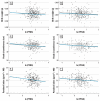Cord serum concentrations of perfluorooctane sulfonate (PFOS) and perfluorooctanoate (PFOA) in relation to weight and size at birth
- PMID: 18008002
- PMCID: PMC2072847
- DOI: 10.1289/ehp.10334
Cord serum concentrations of perfluorooctane sulfonate (PFOS) and perfluorooctanoate (PFOA) in relation to weight and size at birth
Abstract
Background: Recent studies have reported developmental toxicity among rodents dosed with perfluorooctane sulfonate (PFOS) and perfluorooctanoate (PFOA).
Objectives: We examined the relationship between concentrations of PFOS and PFOA in cord serum (surrogates for in utero exposures) and gestational age, birth weight, and birth size in humans.
Methods: We conducted a hospital-based cross-sectional epidemiologic study of singleton deliveries in Baltimore, Maryland. Cord serum samples (n = 293) were analyzed for PFOS and PFOA by online solid-phase extraction, coupled with reversed-phase high-performance liquid chromatography-isotope dilution tandem mass spectrometry. Maternal characteristics and anthropometric measures were obtained from medical charts.
Results: After adjusting for potential confounders, both PFOS and PFOA were negatively associated with birth weight [per ln-unit: beta = -69 g, 95% confidence interval (CI), -149 to 10 for PFOS; beta = -104 g, 95% CI, -213 to 5 for PFOA], ponderal index (per ln-unit: beta = -0.074 g/cm(3) x 100, 95% CI, -0.123 to -0.025 for PFOS; beta = -0.070 g/cm(3) x 100, 95% CI, -0.138 to -0.001 for PFOA), and head circumference (per ln-unit: beta = -0.32 cm, 95% CI, -0.56 to -0.07 for PFOS; beta = -0.41 cm, 95% CI, -0.76 to -0.07 for PFOA). No associations were observed between either PFOS or PFOA concentrations and newborn length or gestational age. All associations were independent of cord serum lipid concentrations.
Conclusions: Despite relatively low cord serum concentrations, we observed small negative associations between both PFOS and PFOA concentrations and birth weight and size. Future studies should attempt to replicate these findings in other populations.
Keywords: Birth weight; cord blood; epidemiology; fetal exposure; fetal growth; gestational age; head circumference; human; length; perfluorooctane sulfonate; perfluorooctanoate; polyfluoroalkyl compounds; ponderal index.
Figures

Comment in
-
Guest editorial: biomarkers of perfluorinated chemicals and birth weight.Environ Health Perspect. 2007 Nov;115(11):A528-9. doi: 10.1289/ehp.10923. Environ Health Perspect. 2007. PMID: 18007963 Free PMC article. No abstract available.
-
PFOS and PFOA in humans: new study links prenatal exposure to lower birth weight.Environ Health Perspect. 2007 Nov;115(11):A550. doi: 10.1289/ehp.115-a550a. Environ Health Perspect. 2007. PMID: 18007977 Free PMC article. No abstract available.
-
Perfluoroalkane acids and fetal growth.Environ Health Perspect. 2008 Jun;116(6):A238; author reply A238-9. doi: 10.1289/ehp.11036. Environ Health Perspect. 2008. PMID: 18560501 Free PMC article. No abstract available.
References
-
- 3M Company. Fluorochemical Use, Distribution, and Release Overview. St. Paul, MN: 3M Company; 1999.
-
- Akaike H. Information theory and an extension of the maximum likelihood principle. In: Petrov BN, Csaki F, editors. Second International Symposium on Information Theory. Budapest: Akademiai Kiado; 1973. pp. 267–281.
-
- Apelberg BJ, Goldman LR, Calafat AM, Herbstman JB, Kuklenyik Z, Heidler J, et al. Determinants of fetal exposure to perfluorinated compounds in Baltimore, Maryland. Environ Sci Technol. 2007;41:3891–3897. - PubMed
-
- Barker DJ. Adult consequences of fetal growth restriction. Clin Obstet Gynecol. 2006;49:270–283. - PubMed
-
- Bernert JT, Jr, Turner WE, Pirkle JL, Sosnoff CS, Akins JR, Waldrep MK, et al. Development and validation of sensitive method for determination of serum cotinine in smokers and nonsmokers by liquid chromatography/atmospheric pressure ionization tandem mass spectrometry. Clin Chem. 1997;43:2281–2291. - PubMed
Publication types
MeSH terms
Substances
LinkOut - more resources
Full Text Sources
Medical

